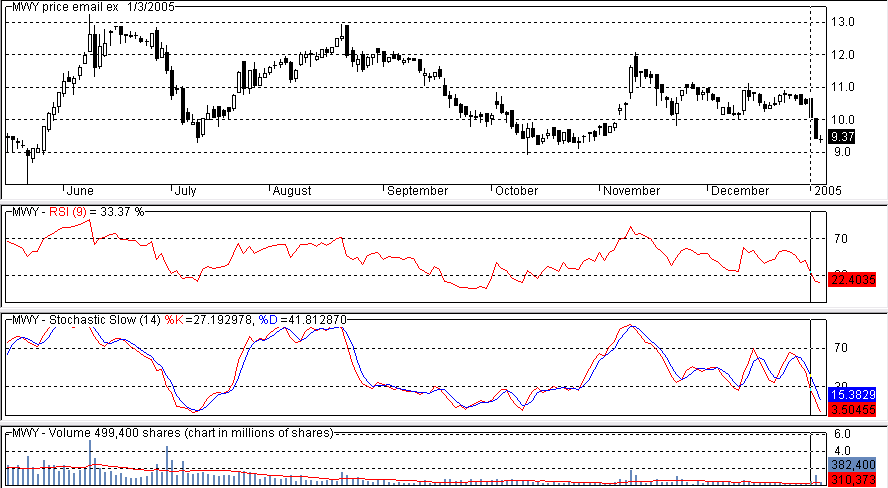![]()
I am often asked which stock market indicators are best or which ones do I use. No doubt opinions on a formula for success vary greatly on this subject. Perhaps one reason is that the field of technical analysis offers so many stock indicators to choose from. Are some really better than others? Are some downright misleading? Well they can be depending on how they are used and just as important, what other stock indicators they are used with.
For example, take a look at the stock chart below of MWY. It uses a couple of very popular indicators, RSI and Stochastic. Do you know why using these two particular indicators together though could provide you with misleading results? Take a look.
What's wrong with this picture?

It's really quite simple. Say for example, there is a car accident. No one is hurt. A policeman arrives though and wants to determine who is at fault. There are several witnesses present who saw the accident but were not involved in it. Which do you think the policeman would find more reliable, taking two statements from the same witness or taking one statement from two different witnesses?
Well you say, "why on earth would he want to take two statements from the same witness, of course he would find statements from two different witnesses more reliable". The same is true of trading. In our example above, by using the RSI and Stochastic indicators we are basically inquiring of the same source twice to check the validity of our trade. Why? Because both indicators work basically the same way. Here is the basic formula for each;
RSI Indicator Formula
RSI=100-(100/(1+(up/down)))
where up = the exponential moving average of the closing prices on the days wehere the close is higher than the prior day during a given period.
where down = the exponential moving average of the closing prices on the days where the close is lower than the prior day during a given period.
Stochastic Indicator Formula
CL = Close (today) - Lowest Low (in %K Periods)
HL =Highest High(in %K Periods) - Lowest Low (in %K Periods)
%K = CL / HL *100
Both indicators measure the velocity of the directional movement of the price by comparing either the closing price, high or low during a given period. Both are also bounded mathematically resulting in them bouncing back and fourth between 0 and 100, making them both oscillators and causing overbought and undersold conditions at times using similar limit lines for this as well.
So while, both of these indicators are great momentum oscillators, it would not do us much good to use both of them. A more reliable approach would be to collect information from at least two different sources, like our policeman did. So if we decided to use one of the above momentum oscillators, we would want to add another type of indicator that provides additional insight to our analysis. Here is just some of what we have available;
Momentum Oscillators (which we are already using in this example) such as RSI and Stochasitics measure momentum and oscillate between set limits or up and down over a center line. Typically these indicators are leading indicators, that is they may give insight into where the price may go in the future.
Trend Following Indicators such as a moving average, MACD or TRIX "follow the trend" or lag behind the present movement and are useful to confirm the direction of the price movement.
Volume Indicators such as a plain volume histogram, OBV or volume oscillator are generally used to measure the strength, weakness and or commitment in price movement.
Volatility Indicators such as Bollinger Bands, or Chalkin Volatility are useful for timing. The one constant regarding stock prices, is that they are not constant. So using a volatility indicator and noting a relative low volatility for example, it can be presumed that the volatility will increase, resulting in a trend, or at least a breakout. Other types of indicators can be used to determine the direction of the price movement.
So no matter which stock market indicators you might like, you would be doing yourself a favor to use a combination of the group above rather than multiple indicators from the same group. Doing this will provide you with a more reliable and complete picture of the current and future price movement resulting in a better chance of making your stock trading successful.
KNOWLEDGE IS POWER Learn more now
TERMS & CONDITIONS:
We at Scientifictrader.com are not financial analysts, advisors or brokers.
Before using any of the information contained in our newsletters or related
web pages, we recommend you seek independent professional legal, tax and
investment advice as to whether the information provided is suitable for
your particular needs and circumstances. Failure to seek detailed
professional personally tailored advice prior to acting on this information
could lead to you acting contrary to your best interests and could lead to
losses of capital. The information provided is meant to be a guide
only, which must be tempered by the investment experience and independent
decision making process of the subscriber.
You agree to hold harmless Scientifictrader.com and it's agents for any loss, financial or otherwise resulting directly or indirectly from this site, its data, content, materials, associated pages and documents and emails, whether accurate and timely or not.
Copyright 2006, All Rights Reserved; stock market indicators